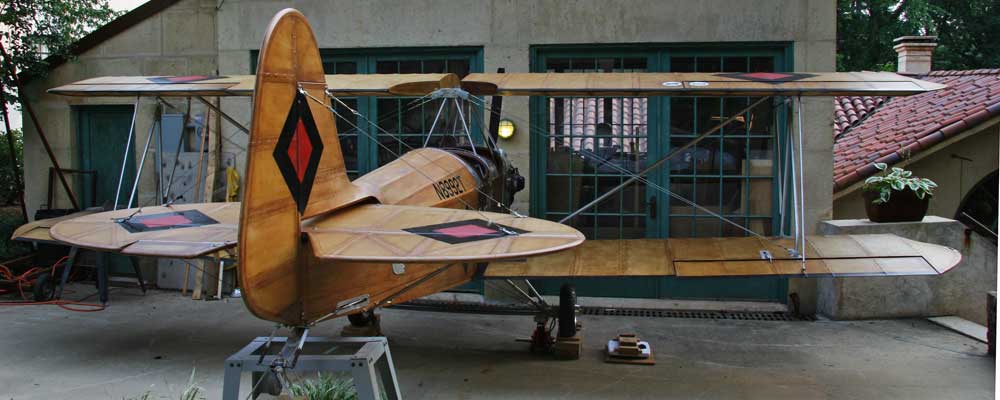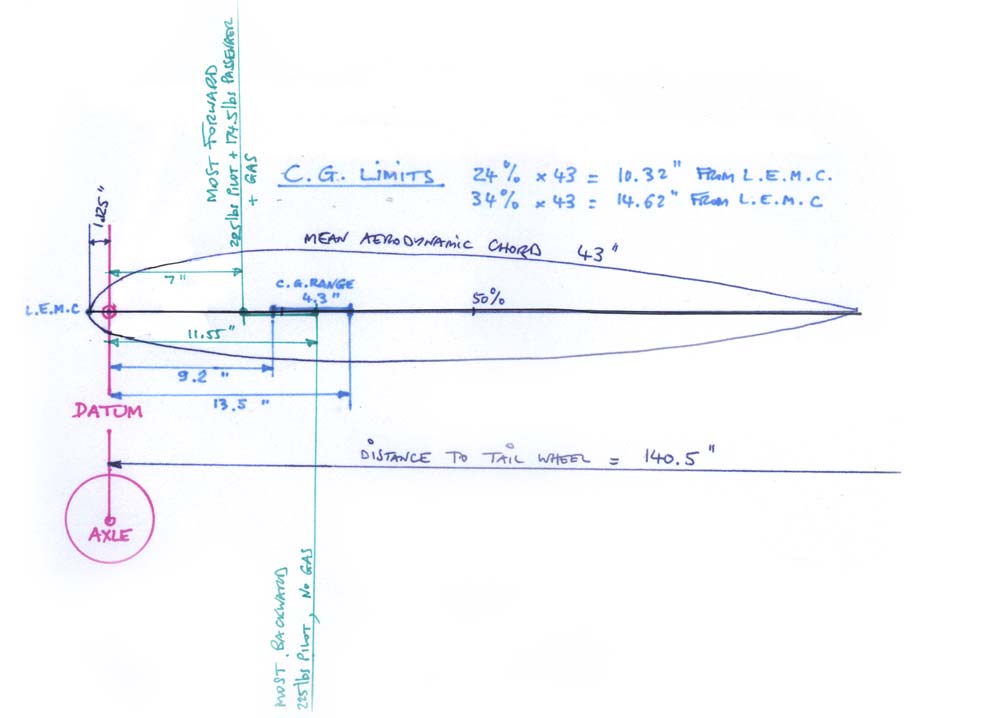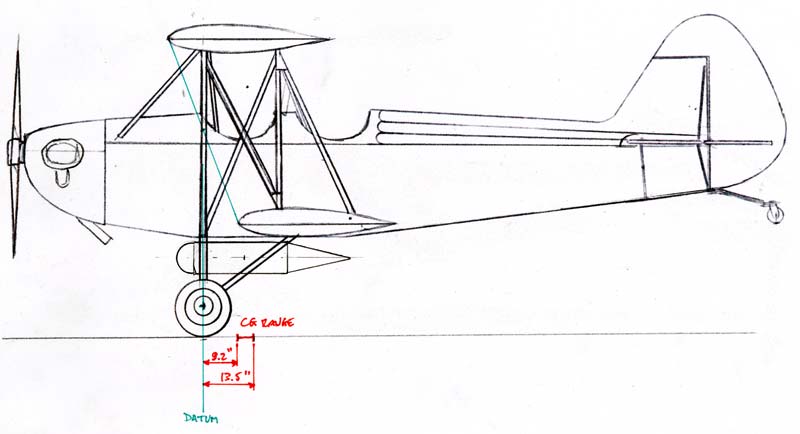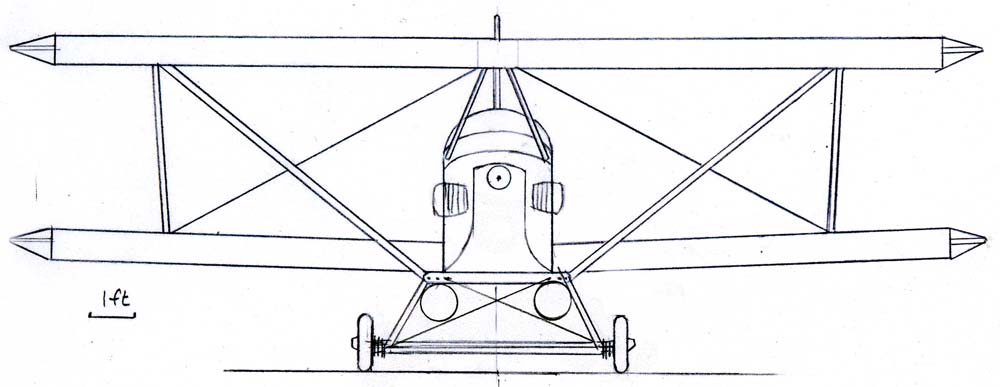
The weight on the tail is now 13.5 lbs instead of naught, which is normal considering the battery weights 13 lbs. The weight on the left wheel is 249.75lbs and the weight on the right wheel is 255.25lbs, so total empty weight is 518.5lbs. Datum is still the axle, 140.5" from the tail wheel.
That places the new center of gravity (13.5 lbs x 140.5") / 518.5lbs = 3.66" back from DATUM , still short of the 5" of the factory plane. I may still have to add some ballast to the tail.
We were almost beyond the range of the scale last time, so I bought another identical scale and built a platform across the pair. I sat still in the cockpit while my godchild moved and read the scales from wheel to wheel. The figures corrected for tare were: LEFT WHEEL 320 lbs, RIGHT WHEEL 326.5 lbs, TAIL WHEEL 46.5 lbs. That gives a total weight with pilot of 693 lbs .
The distance from the DATUM to the tail wheel is 140.5", so the backward moment of the tail is 46.5 lbs x 140.5" = 6523.25 , which places the C.G. 6523.25/691.5 = +9.45" from Datum, within range. But with a full tank of gas and oil, it would probably move too far forward. A 225lbs pilot would bring it back another: (50 x 31) / 743= 2.1".
The TAIL WHEEL WEIGHT is now 50lbs. The weight of the gas is 42lbs. The total weight is now 870.5 + 42= 912.5lbs . That places the CG : (50 X 140.5) / 912.5 = 7.7" FROM datum, 1.5" out of range. Adding the gallon of oil to the engine would make it worse by: (7.5lbs x 61") / 920 = .5" , a total of 2" too forward.
But this is with a relatively light weight pilot(me or Dave). In the most nose heavy situation(pilot, passenger, gas), Bob's extra 50lbs in the pilot seat , approximately 31" back from DATUM, would help and move it back : (50 x 31) / (920 + 50)= 1.6" , almost within range.
On the other hand, with Bob's 225lbs in the passenger seat, CG would be even more forward by approximately another : (50 x4) / 970= .2"

As my early estimates had shown, I am still nose heavy, and will need ballast or a heavier tail wheel, or both, to be able to carry a passenger and full gas. The CG has to move at least 2.2" back in order to stay within range in all conditions from most nose heavy to most tail heavy. It will in fact cover the full allowed range. Let's calculate the value of B, the ballast weight needed to do that in that configuration. We have the following equation: (B x 140.5) / (912.5 + B) = 2.2 , which makes 140.5 B = 2007.5 +2.2B , 138.3B = 2007.5, B = 2007.5 /138.3 = 14.51lbs. That is BAD, a lot more than I ever expected.
The Matco 6" solid rubber tail wheel weights about 5 lbs , and would bring the C.G. within range with just the pilot on board, which is going to be the case at least for the 40 hrs of test , and may be for good if the plane ends up being a single seat airplane. So the question is: do I just install the Matco wheel and forget about the rest of the ballast for the moment, and see how the plane flies? I would have to talk to my FAA inspector about that.

My friend Dave suggested a radical solution which I got to rather like after thinking about it: move the gas tank back . It is a little late in the game to install wing tanks without major surgery. What I am actually thinking of doing is hanging 2 bomb shaped aluminum gas tanks under the fuselage. They would be virtually centered on the CG, and fuel would therefore have no effect on it. They could be strapped to the gear legs. I could actually leave the existing gas tank where it is(removing it would have a marginal effect on the CG), and connect it to the bottom tanks, which would be filled through it from the top. That would also allow me to carry twice as much gas if I ever attempted a cross country flight alone.
The plumbing would require some thinking, as I would need to interconnect the 3 tanks, have a breather line go back from the 2 bottom to the top tank, the fuel valve would be moved to the bottom tanks, and a gauge installed in one of them.

Making the tanks wouln't be easy, and I would have to find a spun aluminum round nose for them. To hold the same 8 GLS as the original tank, they would need to be about 7 to 8 inches in diameter and 3 feet long.
The only objection I have is that in case of a really bad landing, if the gear collapses..., it probably wouldn't be pretty... Could I place them on each side of the fuselage instead, just above the bottom wings?
| L A S T M O N T H | N E X T M O N T H | B A C K T O I N D E X |